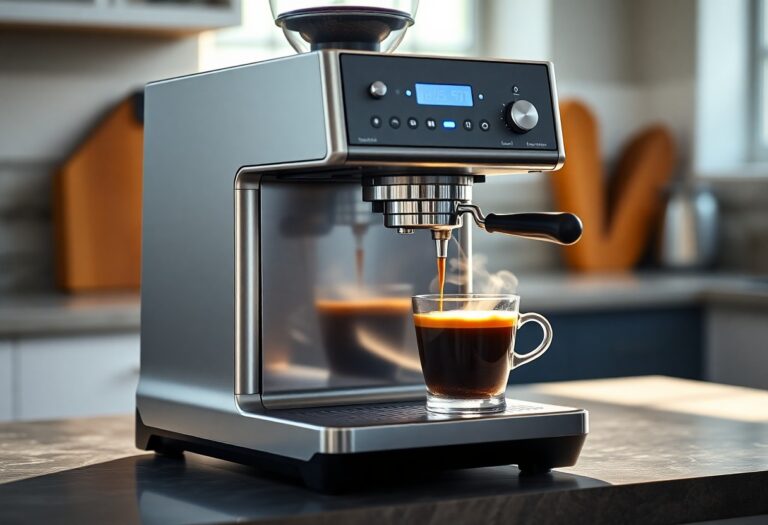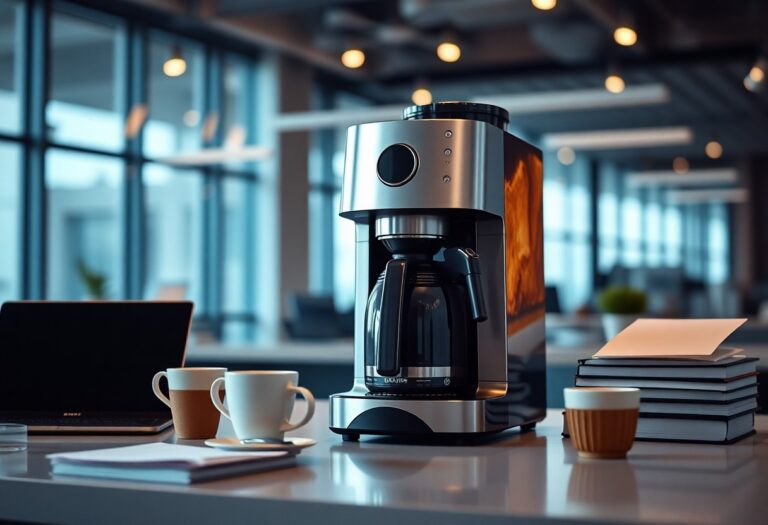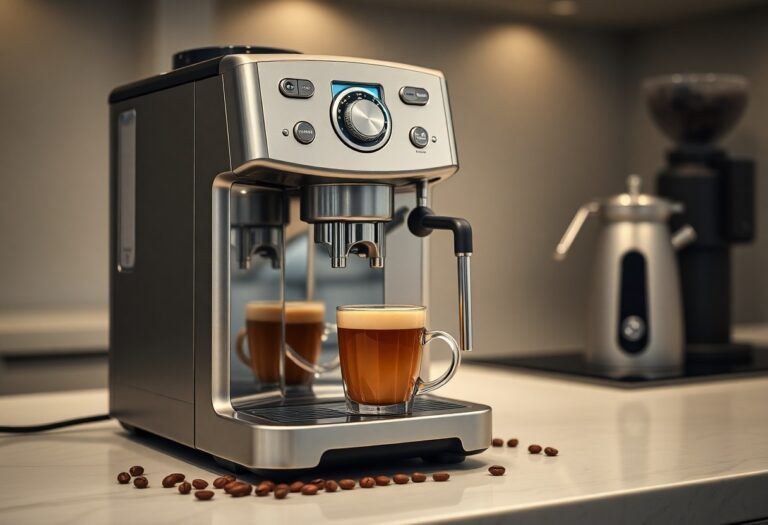What Type of Coffee for a Drip Machine – Brewing Compatibility
Brewing the perfect cup of coffee in a drip machine hinges on the choice of coffee you select. To achieve that rich, aromatic flavor you desire, it’s imperative to choose medium to coarse ground coffee that works harmoniously with your machine. Using freshly roasted beans can enhance the taste, but be mindful of the roast level; a darker roast may lead to a bitter cup while a lighter roast can yield a more acidic flavor. For more insights, check out What Type of Coffee Is Used In a Coffee-Maker? to expand your brewing knowledge.
Key Takeaways:
- Choose coffee grounds that are specifically labeled as suitable for drip coffee makers, typically medium grind.
- Freshness plays a significant role; opt for recently roasted beans for the best flavor and aroma.
- Consider the coffee-to-water ratio; a standard recommendation is about 1 to 2 tablespoons of coffee per 6 ounces of water.
- Experiment with different coffee origins and blends to find a profile that matches your taste preferences.
- Pay attention to the brewing temperature; optimal brewing occurs between 195°F and 205°F to extract the best flavors.

Selecting the Right Bean: Arabica vs. Robusta
Choosing the right bean can significantly affect your coffee’s flavor and overall satisfaction. The two primary varieties are Arabica and Robusta. Arabica beans offer a delicate, nuanced flavor profile with notes of fruit and sugar, making them a favorite among many coffee aficionados. In contrast, Robusta beans are known for their strong, bold taste and earthy undertones, often accompanied by a higher body and richer crema, which some may prefer in darker roasts.
Flavor Profiles and Characteristics
Arabica typically contains a diverse range of flavors, which can include hints of chocolate, caramel, or berry, driven by its higher acidity. Robusta, with its more bitter, earthy aromas, has a thicker consistency and can feature nutty or woody notes. If you appreciate a smoother, complex cup, Arabica is likely your best choice; for those who enjoy intense flavor and robust strength, Robusta may be more appealing.
Caffeine Content Considerations
Caffeine content varies significantly between Arabica and Robusta beans, with Robusta containing nearly double the caffeine of Arabica. A typical Arabica bean has about 1.2% to 1.5% caffeine, while Robusta hovers around 2.2% to 2.7%, making it a go-to for an energy boost. This factor is crucial to consider, especially if you tend to consume multiple cups throughout the day.
Robusta’s higher caffeine concentration not only lends a more potent kick but also contributes to pest resistance, making it easier to cultivate in challenging environments. Consequently, numerous commercial blends incorporate Robusta for its robustness in flavor and cost-effectiveness. However, if you’re sensitive to caffeine or prefer milder options, Arabica might be more suitable to limit your intake without sacrificing taste. Do not forget, your choice in beans can tailor the coffee experience to your personal preference and lifestyle needs.
The Grind: How Particle Size Affects Extraction
Your coffee’s grind size plays a pivotal role in the extraction process during brewing. A finer grind exposes more surface area, speeding up extraction, while a coarser grind slows it down. This variation can significantly influence the flavor profile of your final cup, affecting everything from bitterness to acidity. For drip machines, achieving a consistent grind is vital to ensure even extraction and a balanced flavor, so understanding how different grind sizes interact with your brewing method can elevate your coffee experience.
Coarse vs. Medium Grind Specifications
A coarse grind resembles sea salt and is ideal for slower extraction methods, while a medium grind is similar to granulated sugar and is well-suited for drip machines. The larger particles in a coarse grind resist extraction, resulting in a less intense flavor that can highlight subtle notes. In contrast, a medium grind enables a balanced extraction, producing a better-rounded cup that captures both acidity and sweetness effectively. Choosing the appropriate grind ensures that you brew a coffee that aligns with your taste preferences.
The Science Behind Consistency in Brewing
Consistency in grind size is vital for achieving a uniform extraction that impacts your coffee’s flavor. If your grind contains uneven particle sizes, some coffee grounds may over-extract, becoming bitter, while others may under-extract, leading to sour notes. An ideal grind delivers equal flavor across each sip, maintaining balance and complexity. This consistency can be optimized through high-quality grinders, which offer precision and control over particle size, ensuring a better brewing experience in your drip machine.
Investing in a burr grinder may be an excellent choice, as it provides the ability to adjust grind settings for various brewing methods. For drip coffee, a setting that produces a medium grind is often recommended. Studies have shown that uniformity in particle size can improve extraction rates by up to 20%, allowing you to appreciate the full spectrum of flavors that the coffee bean offers. Achieving this consistency not only enhances your taste experience but also allows you to replicate great coffees with every brew without guesswork.
Roast Levels: Matching Roast to Your Drip Machine
The roast level of your coffee beans significantly influences the flavor profile and overall brewing experience in a drip machine. Understanding the intricacies of light, medium, and dark roasts allows you to tailor your coffee to your personal preferences and enhances the brewing compatibility of your drip machine.
Light, Medium, and Dark Roast Comparisons
| Light Roast | Bright acidity, floral and fruity notes, often lacks the depth of flavor compared to darker roasts. |
| Medium Roast | Balanced flavor, hints of caramelization, well-rounded sweetness, and moderate acidity. |
| Dark Roast | Intense, smoky flavor with low acidity, often brings out chocolatey or nutty undertones. |
Impact on Brewing Time and Flavor Complexity
The roast level of your coffee directly affects brewing time and flavor complexity in your drip machine. Generally, light roasts require a longer brewing time to extract the subtle flavors fully; whereas, dark roasts offer a faster brewing process due to their porous nature, enhancing boldness quickly. The flavor complexity can vary significantly—while lighter roasts showcase intricate taste notes, dark roasts provide a simplified yet rich experience, making it important to align the roast level with your desired outcome.
If you prefer a complex cup brimming with bright acidity and delicate floral notes, you might find yourself gravitating toward light roasts. On the other hand, dark roasts appeal to those who enjoy the robust and straightforward flavors that stand out immediately, often benefiting from shorter brewing times in a drip machine. Ultimately, tailoring the roast level to your personal taste and the brewing mechanics of your drip machine can elevate your morning ritual from ordinary to extraordinary.

Water Quality and Temperature: The Unseen Influencers
The quality of water you use and its temperature are often overlooked factors that can significantly impact the flavor of your brewed coffee. Clean, filtered water enhances extraction, ensuring that the coffee oils and flavors are fully realized. Additionally, maintaining the right temperature during brewing is necessary for optimal flavor extraction, preventing under-extraction or over-extraction. For more insights on perfect brewing, explore the Drip Coffee Brew Guide.
| Aspect | Recommendation |
|---|---|
| Water Source | Filtered or bottled water |
| pH Level | Neutral (around 7) |
| TDS Level | Between 150-250 ppm |
Ideal Water Composition for Brewing
Your coffee’s flavor can be dramatically altered by the water you use for brewing. Ideal water should have balanced mineral content with a TDS (Total Dissolved Solids) level between 150-250 ppm. This range allows necessary minerals like calcium and magnesium to enhance extraction without overpowering the coffee’s natural flavors. Aiming for a neutral pH of around 7 ensures that your coffee isn’t influenced negatively by overly soft or hard water.
Temperature Guidelines for Optimal Extraction
Optimal water temperature plays a pivotal role during the brewing process. The ideal temperature range for drip coffee is between 195°F to 205°F (90°C to 96°C). This range ensures that you extract the full spectrum of flavors while avoiding bitterness from over-extraction. If your water temperature is too low, you risk a sour and underwhelming brew.
| Temperature (°F) | Effect on Coffee |
|---|---|
| Below 195 | Under-extraction leading to sour flavors |
| 195 – 205 | Optimal extraction, balanced flavor profile |
| Above 205 | Over-extraction resulting in bitterness |
Staying within the recommended temperature range can enhance the overall experience of your coffee. Brewing at too low of a temperature results in sour, underdeveloped flavors, while overly hot water can extract undesirable bitter compounds. The right balance allows the coffee to flourish, resulting in a cup that’s rich and satisfying.
| Key Points | Impact |
|---|---|
| Water Temperature (195°F – 205°F) | Promotes balanced flavor extraction |
| Filtered Water | Enhances flavor clarity and reduces bitterness |
Brewing Techniques: Fine-Tuning Your Drip Machine Experience
Maximizing your drip machine’s potential is all about honing in on the right techniques. Adjusting variables like water temperature, brewing time, and grind size can transform your cup from mediocre to exceptional. Experiment with different combinations to highlight the flavor notes specific to your coffee beans. Your attention to detail may lead to surprising and delightful flavor discoveries, enhancing your overall coffee experience.
Adjusting Brew Strength Settings
Tweaking the brew strength settings on your drip machine allows you to tailor your coffee intensity. Many models offer options ranging from mild to bold, accommodating various taste preferences. If you prefer a stronger cup, opt for a bolder setting or increase your coffee-to-water ratio; conversely, adjust down for a milder brew. Experimentation here helps you find the perfect balance that suits your palate.
Maintenance Tips for Consistent Results
A well-maintained drip coffee machine ensures consistency and quality in your daily brews. Regularly clean your machine, descaling every few months to remove mineral buildup, and replace coffee filters or wash reusable ones after each use. Additionally, avoid using water with a high mineral content, as it can affect flavor and machine performance. The longevity and quality of your coffee depend on how well you care for your equipment.
- Clean your coffee machine regularly for consistent flavor.
- Descale every few months to prevent mineral buildup.
- Use fresh water to maintain optimal taste.
- Inspect and replace filters for untainted brews.
Neglecting maintenance can lead to frustrating results, impacting both taste and machine functionality. Even a small residue of old coffee or water deposits can disrupt the brewing process. Developing a simple cleaning routine ensures that your drip machine operates smoothly, allowing for an extraordinary cup of coffee every time. The best cups often come from well-looked-after machines.
- Develop a cleaning routine for your personal schedule.
- Store your coffee beans properly to prolong their freshness.
- Replace worn parts, such as filters or carafes, as needed.
- Stay informed about your machine’s specific requirements.
To Wrap Up
From above, you’ve learned that the best coffee for your drip machine largely depends on personal preference but is generally characterized by a medium grind, fresh beans, and a balanced flavor profile. By selecting blends or single-origin coffees that complement your taste—whether you prefer bold, floral, or nutty notes—you can enhance your brewing experience. Pay attention to freshness and consider your brewing ratios to optimize flavor extraction. Ultimately, the right choice of coffee will elevate your daily brew, making your morning ritual even more enjoyable.
FAQ
Q: What type of coffee grounds should I use in a drip coffee machine?
A: For a drip coffee machine, it’s best to use medium grind coffee. This grind size allows for optimal extraction of flavors during the brewing process without clogging the filter or over-extracting the coffee. Avoid using finely ground coffee, which can lead to a bitter taste and a muddy brew.
Q: Can I use flavored coffee in a drip coffee machine?
A: Yes, flavored coffee can be used in a drip coffee machine. However, it’s advisable to check if the flavoring is oil-based, as oily coffee grounds can cause issues with clogging the filter. Opt for flavored coffees that use natural flavoring or are designed specifically for drip machines to ensure the best brewing experience.
Q: Is it okay to mix different types of coffee beans in a drip machine?
A: Mixing different types of coffee beans can create unique flavors and enhance the taste of your brew. However, make sure to blend beans with similar grind sizes and roast profiles to ensure even extraction. Experimenting with different ratios can lead to an enjoyable cup, allowing you to find a mix that suits your palate.
Q: How much coffee should I use for a drip coffee machine?
A: A general guideline is to use one to two tablespoons of coffee grounds for every six ounces of water. The amount can be adjusted based on personal preference for strength. Keep in mind that using too little coffee may result in a weak brew, while too much can lead to a bitter taste.
Q: Does the freshness of coffee beans impact the brewing compatibility with a drip coffee machine?
A: Yes, the freshness of the coffee beans significantly impacts the flavor and aroma of your brew. Freshly roasted and ground coffee delivers the best results, as it retains more of its natural oils and flavors. Aim to use coffee beans within 2-4 weeks of roasting for optimal taste, and store them in an airtight container to preserve freshness.







